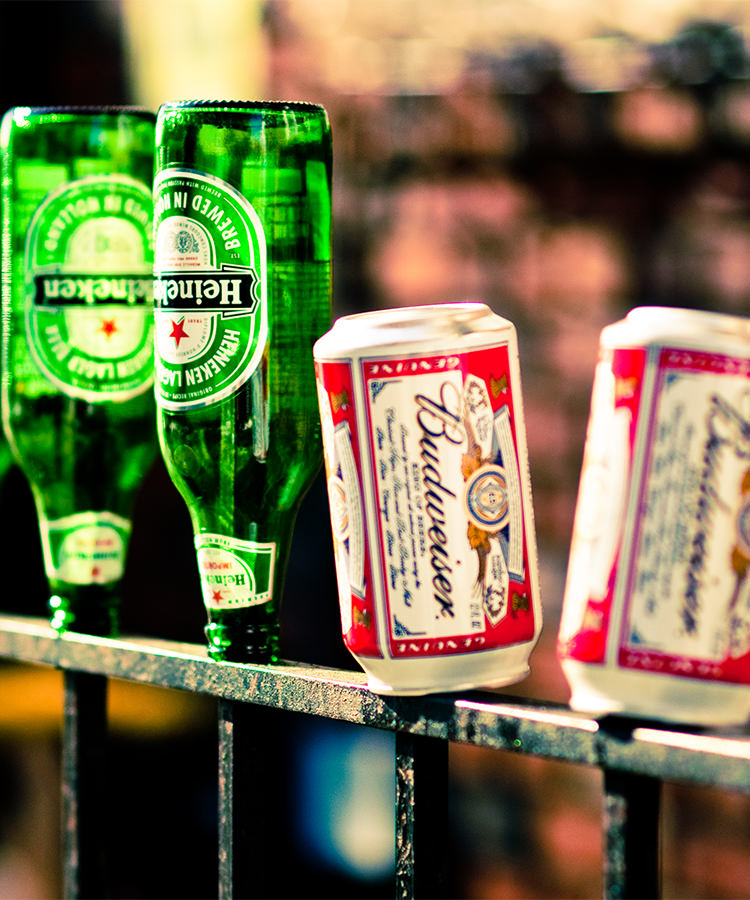If you order a run-of-the-mill bottle of beer in America, you can count on getting 12 fluid ounces. In Germany, beer is bottled in 11.2 or 16.9 ounces. Go over to England, and you’re likely to find cans that are 440 milliliters, or around 14.8 ounces.
What gives? Why are beers in the land of plenty often smaller than those of their forebears?
Like many things in America, the answer involves transatlantic immigration and constantly evolving federal regulatory boards. And, in this particular case, an ambitious St. Louis brewer by the name of Adolphus Busch.
History in a Bottle
In the 1700s, beer options were few in the New World. According to Bill Lockhart, a member of the Society for Historical Archaeology, English colonists shipped their lightly carbonated ales and porters to the Americas in large-format ceramic bottles sealed with cork. But by the 1840s, German immigrants had transformed American beer. Highly carbonated, Teutonic-style lager was the order of the day, and served on tap in bars only because the beer would spoil in bottle.
In 1872, a Texas brewery called Anheuser-Busch adopted what was then cutting-edge pasteurization technology (merci, Louis Pasteur!) to bottle and ship its German-style lagers across the country, thereby becoming the first nationally available beer label. To package his wares, Adolphus Busch opted for 26-ounce “Apollinaris” sparkling water bottles, named for the Apollinaris Spring in Germany.
“Bottles for carbonated soda had been used for decades, and these could certainly have contained beer,” Lockhart writes. “But they were relatively small, holding 6 or 7 ounces. Although we may never know for sure, we can guess that Busch, a heavy beer drinker himself, wanted a larger size.”
How the West Was Drunk
When Anheuser-Busch shipped its Apollinaris bottles to the Western territories, drinkers rarely brought them back to be reused. Enter the “export bottle,” originally designed by another German immigrant, Valentine Blatz, in Milwaukee, Wisconsin in 1873.
The first export bottles were also 26 ounces, but by 1910, 8- and 12-ounce bottles were becoming more popular. The 12-ounce export bottles are the classic, 12-ounce longneck beer bottles with a neck that slightly bulges in the middle. Think Corona bottle, but in amber or green glass. By 1913, thanks to Anheuser-Busch’s massive distribution network, the 26-ounce beer bottle was discontinued in favor of the 8- and 12-ounce export bottles.
Just seven years later, the U.S. would have a hard reset on the entire alcohol business. Prohibition lasted from 1920 to 1933, rendering beer bottles inutile. When companies finally came back to fill the thirst gap, they adopted a 12-ounce standard. Post-industrialization, the new standard just stuck, right up until Coors introduced its 12-ounce, all-aluminum can in 1959.
The New Normal
In 1971, however, the U.S. government-run National Institute on Alcohol Abuse and Alcoholism (NIAAA), an organization run by the National Institutes of Health, defined “the typical drink” as a pint, or 16 ounces, of a 5-percent beer.
That remained the standard until the 1980 launch of the Dietary Guidelines for Americans (DGA), a study published every five years by the U.S. Departments of Agriculture and Health and Human Services. The DGA defined a “standard-size drink” as, “Twelve ounces of regular beer, 5 ounces of wine, and 1 1/2 ounces of distilled spirits contain about equal alcohol.” Why the government went back to 12 ounces wasn’t explained, but it matched the bottle and can size of most beer sold at the time.
Today, the tides are turning. Contemporary craft breweries increasingly market beers, particularly IPAs, in German-sized, 16-ounce cans. This is less a stylistic bid for internationalism than an economic necessity.
“There’s a standard price point with 16-ounce cans (for craft breweries),” Joshua Stylman, the co-founder of Threes Brewing in Brooklyn, tells me. “You can sell a four-pack for $16 to $18, but if you correlate that price ounce-wise to 12-ounce cans, people don’t want to buy six-packs. We started going through the math and we’re actually getting hosed on 12-ounce cans.”
Beer trends come and go. While 16-ounce cans of trendy IPAs are on the rise, the Adolphus Busch’s preferred 26-ounce bottles are exceedingly rare. But what has remained a constant during the last 50 years is the 12-ounce beer can and bottle.
Sure, size matters; but access to great beer matters most.
